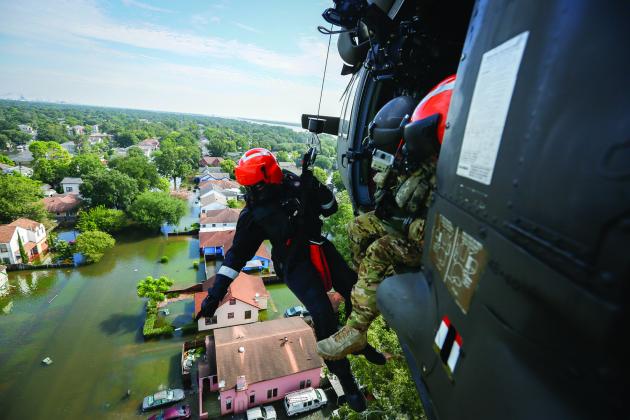Brit Featherston was enjoying a cup of coffee and the company of his new baby when a dreadful air took over the ambiance of his Lufkin-area home. Shortly thereafter, the whole place began to shake.
“I go outside and a washing machine falls onto my driveway,” Featherston said, remembering the raining debris that covered East Texas when the Columbia Space Shuttle exploded over Texas on Feb. 1, 2003. Then working in the field, the now-U.S. Attorney for the Eastern District of Texas remembers getting boots on the ground immediately.
“In this sense, nobody is prepared for anything,” Featherston said.
Space shuttles falling from the sky is a rare event indeed – and hard to plan for. However, Featherston and other community leaders want to prepare for the unpredictable – as well as the all too predictable – in an effort to make sure Southeast Texas can take care of itself in whatever disaster that may come this way.
Hurricanes: So many have hit the Gulf Coast, the next one’s impact is just a matter of time. Refinery explosions: Been there. School shootings: They happen in communities just like those in Southeast Texas. Washing machines falling from the sky: At least one man on the team has experience with how to handle it.
At a Lamar University Recovery and Resilience Academy (RRA) workshop held July 26 and 27, Featherston was joined by other first responders, elected leaders, law enforcers, investigators and some of the brightest minds Southeast Texas has in powerful positions to form a brain trust focused on how to bring the community through any number of disasters. The ultimate goal of the RRA is to bring together stakeholders across many disciplines to work in tandem with the local community to provide information about emergency preparedness and ways to mitigate potential losses and damages.
Reflecting back to the Columbia explosion, Featherston recalled the massive scale of the mission – and just how unprecedented the work was.
Featherston’s colleague, former FBI special agent and current Lamar University criminal justice educator Mark Broome, added that the mission at hand was so novel there was no plan.
Looking through his handy-dandy book of procedures to follow for myriad disasters, Broome said, “Space shuttle falling from the sky” wasn’t covered. Broome then made a call to the then little-known and even lesser-utilized FEMA (Federal Emergency Management Agency). Once reached, FEMA reps reported that they would be on site by the next Wednesday, Broome said.
“Somebody needed to be there that day,” Broome insisted. So, with no pre-plan in place, and no one stepping up to lead from FEMA, Broome made a judgment call: He and his team would help immediately.
“Take action,” Broome said of his philosophy when encountering disaster. “Do something when the time comes.
“It’s easy to say, hard to do.”
But, as Broome would sum up, it isn’t impossible.
Broome and Featherston may have been some of the first responders to step up when tragedy struck, but they wouldn’t be alone for long. Nearly 500 agencies arrived to offer assistance, 25,000-plus people converging in the area to lend hands with rescue and recovery. A 2018 book by former NASA launch director Michael Leinbach and Jonathan Ward, “Bringing Columbia Home: The Untold Story of a Lost Space Shuttle and Her Crew,” described the space shuttle Columbia search operation as the largest in U.S. history.
Now nearly 20 years in the future, Featherston and Broome are still on the forefront of disaster response in Southeast Texas – as are many familiar faces that have worked together in tragedy after tragedy on the local level. Networking with those who will “do something when the time comes” has been Broome’s path to success, dating back to Columbia, but also holding true in hurricane season.
“I knew everybody in the room,” Broome said. “If you’re handing out business cards when we’re ass-deep in water, you’re already behind the curve.”
Featherston agreed.
“It is important to have those conversations before disaster arrives,” Featherston said.
Once a natural disaster is imminent, it’s too late to make new relationships that would have the same benefit as those refined over time. Even with the best-laid plans in place, and a team on the same page, Featherston said disaster response, “will always be chaotic, no matter how much you prepare.”
“By definition,” Featherston added, “hurricanes are chaotic.”
“There’s always a sideshow.”
In fact, Featherston and his cohorts described, oftentimes there’s a pre-show, a main show, a sideshow and an after show.
As Broome indicated, Southeast Texas is no stranger to disastrous storms – Harvey, Rita, Ike, Laura… Among the dozens of agencies represented at the workshop, invited guests including Jefferson County Sheriff Zena Stephens and Beaumont Emergency Management Coordinator Tim Ocnaschek were also asked to address what steps and procedures are working for our storm disaster response – as well as what’s not working.
Group conversations and real-life presentations and models were explored, with plans to continue the dialogue and the evolution of the community’s disaster response. Local leaders reflected on how Southeast Texas could have fared even worse in past storms if there wasn’t forethought to create a plan locally following Hurricane Katrina’s impact in New Orleans.
As many in the audience remembered vividly, within a matter of weeks of Katrina’s landfall, Southeast Texas experienced its own hurricane.
“It’s amazing what you can learn,” Featherston half-joked, from watching where others have failed. “Pre-Katrina, there had not been a real government response.
“Don’t wait on the government.”
Incoming Jefferson County District Attorney Keith Giblin, also a former federal court agent, detailed the prosecutorial work to be done in the aftermath of a natural or man-made disaster. According to the longtime lawman, predators such as scam contractors prey on those already experiencing hardship, especially those over a certain age or under a certain income bracket.
“We get inundated with contractor fraud,” Giblin said, adding that in his 60-plus years of being in Texas, he hasn’t seen a real uptick of looting in the aftermath of natural disasters.
“There is a lot – a lot – of cooperation between us,” Giblin said, pointing to his contemporaries in the FBI office, U.S. Attorney’s Office, local police departments, and Lamar University. Together, Giblin et al have answered the call to man the aftermath of unprecedented tragedy, defend life and property in natural calamities, reclaim a community in the wake of a plant explosion, and even secure justice in one of the most heinous and brutal crimes ever committed in America.
Jefferson County Criminal District Court Judge John Stevens, whose business card was exchanged long before the water got deep, reflected on his days in the local U.S. Attorney’s Office, as well as the fateful day he received a call to answer a tragedy he had never anticipated.
“It’s not something you forget,” Stevens said. “The U.S. Attorney General doesn’t just call you.”
But, on June 8, 1998 – a Monday that Stevens will remember his whole life – the assistant U.S. Attorney walked into work with U.S. Attorney General Janet Reno holding on the phone to talk to him. The night before, Stevens learned, a man had been drug to death and his body parts found along a dirt road and ditch in rural Jasper – about an hour’s drive from “big city” Beaumont.
James Byrd Jr., Stevens explained, thought he was in luck when he was offered a ride home on June 7, 1998. Instead, what awaited Byrd was a night of torture that would haunt Stevens for years.
According to Stevens, Byrd’s assailants tied the man, by his feet, to the back of a truck and drug Byrd until he was dead.
“Go help those people and see that justice is done,” Stevens quoted of Reno’s instruction. It wasn’t easy; it wasn’t pretty; but justice was earned in the prosecution of three white men who killed Byrd in a hate crime act that shocked the core of the community. The senseless loss of life, and the dismal impetus of the act, was not unlike the 9/11 terror attacks. Byrd’s death and the lives lost in the 9/11 attacks were akin in that they both also brought out the best in people just as it showcased the worst in people.
“You never know when you’re going to be the representative in a battle of good versus evil,” Stevens described.
July 28, exactly 22 years ago to the day of this publication, the team of federal and state investigators and prosecutors that prosecuted the murderers in Byrd’s death were honored by Reno – and the American public – for their swift and tactical response to the hate-motived death of the Jasper man.
Receiving the Attorney General’s Award for Exceptional Service, the department’s top honor, Stevens was joined by Featherston, Broome, and others.
“Within hours of the discovery of Byrd’s body, a team of local and federal personnel began an exhaustive investigation which revealed that Byrd had been brutally murdered by three white supremacists who chained him by his ankles to the back of a pick-up truck, dragging him almost three miles to his death,” Reno’s proclamation of the Southeast Texas lawmen detailed. “The cooperative efforts of this team of investigators and prosecutors ultimately led to the conviction of all three defendants responsible for a crime that shocked the nation.”
Reno’s praise for the local team’s “cooperative efforts” didn’t dominate her commentary, but cooperation did serve as a dominating force that resulted in success, Stevens explained.
“It’s important to have those connections before disaster arrives,” Featherston agreed. “It will always be on the fly, no matter how prepared you are.”
LU associate professor and Criminal Justice Program Director Dr. Cheng-Hsien Lin said the July workshop will be the first in a series of its kind hosted by the academy, but in the future, they are hoping to become an “informational hub” for the Southeast Texas community in times of need.
“We are hoping to get guidance from community leaders on things that we may not be aware of when it comes to disasters and to figure out how we can help,” Lin said. “We want to continue these trainings for the community and find out what it is that they need. The more that we know, the better we can prepare to assist them and we’ll be able to recover from disasters quicker.”
Karen Roebuck, former United States Probation Officer Supervisor and Lamar University Criminal Justice Instructor, said that “seconds matter,” when disaster strikes, and workshops like the one this week are “for us to be better prepared.”
“Networking is the name of the game,” Roebuck explained, “so we’re not standing there in at least knee-deep water.
“I don’t want us to be a Uvalde.”










